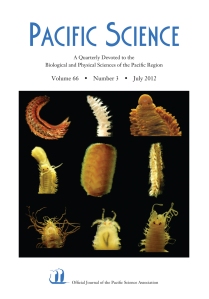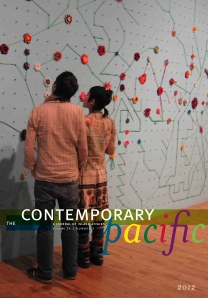After serving as University of Hawai‘i Press’ director for more than two decades, William Hamilton will be retiring at the end of the year. Applications and nominations for the director position are now being accepted. For more information go to http://www.manoa.hawaii.edu/executivesearch/uhp/.
News and Events
Pacific Science, vol. 66, no. 3 (2012)
Biology and Impacts of Pacific Island Invasive Species. 8. Eleutherodactylus planirostris, the Greenhouse Frog (Anura: Eleutherodactylidae)
Christina A. Olson, Karen H. Beard, and William C. Pitt, 255–270
The greenhouse frog, Eleutherodactylus planirostris, is a direct-developing (i.e., no aquatic stage) frog native to Cuba and the Bahamas. Continue reading “Pacific Science, vol. 66, no. 3 (2012)”
Yearbook of the APCG, vol. 74 (2012)
Presidential Address: Revealing the Origin of Human-Nature Dualities in Christian Political Structures
Martha L. Henderson, 15
Continue reading “Yearbook of the APCG, vol. 74 (2012)”
Victoria Kneubuhl Featured on NPR’s Crime in the City
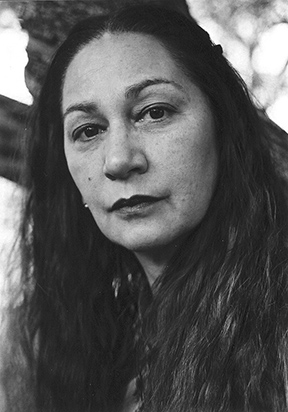 Each summer, National Public Radio’s Morning Edition airs its Crime in the City series featuring mystery writers as they take listeners on insider tours of their home cities. The August 13 installment highlights Honolulu when author/playwright Victoria Nalani Kneubuhl guides NPR correspondent Renée Montagne to the locales described in Murder Casts a Shadow and Murder Leaves Its Mark. The two mysteries bring to life 1930s Hawai‘i, with journalist Mina Beckwith and playwright Ned Manusia as an unlikely pair of sleuths, a colorful cast of characters, and a rich sense of time and place.
Each summer, National Public Radio’s Morning Edition airs its Crime in the City series featuring mystery writers as they take listeners on insider tours of their home cities. The August 13 installment highlights Honolulu when author/playwright Victoria Nalani Kneubuhl guides NPR correspondent Renée Montagne to the locales described in Murder Casts a Shadow and Murder Leaves Its Mark. The two mysteries bring to life 1930s Hawai‘i, with journalist Mina Beckwith and playwright Ned Manusia as an unlikely pair of sleuths, a colorful cast of characters, and a rich sense of time and place.
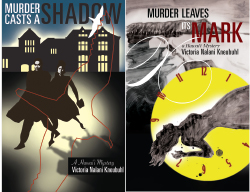 Catch the program by tuning to your local NPR Morning Edition broadcast on Monday, August 13. Hawaii Public Radio will air the segment at 6:50 a.m. on FM88.1 KHPR. (Other U.S. locations are scheduled for 6:50 a.m. & 8:50 a.m. EDT and 5:50 a.m. & 7:50 a.m. PDT.) UPDATE: The show is archived on the NPR website.
Catch the program by tuning to your local NPR Morning Edition broadcast on Monday, August 13. Hawaii Public Radio will air the segment at 6:50 a.m. on FM88.1 KHPR. (Other U.S. locations are scheduled for 6:50 a.m. & 8:50 a.m. EDT and 5:50 a.m. & 7:50 a.m. PDT.) UPDATE: The show is archived on the NPR website.
Read an excerpt from Murder Casts a Shadow here.
Now available as e-books:
Google Play | IndieBound | iTunes | Kindle
China Review International, vol. 18, no. 1 (2011)
FEATURES
Why Form Matters: A Systematic 21st Century Shihua on the Song Dynasty Poet He Zhu (reviewing Stuart H. Sargent, The Poetry of He Zhu (1052–1125): Genres, Contexts, and Creativity)
Reviewed by Michael A. Fuller, 1
Soft Power and the Rise of China: An Assessment (reviewing Sheng Ding, The Dragon’s Hidden Wings: How China Rises with Its Soft Power)
Reviewed by Eric Hyer, 6
Criminal Justice in China: The Place of Incarceration (reviewing Klaus Mülhahn, Criminal Justice in China: A History)
Reviewed by Thomas Buoye, 14
Continue reading “China Review International, vol. 18, no. 1 (2011)”
Journal of World History, vol. 23, no. 2 (2012)
ARTICLES
Chordophone Culture in Two Early Modern Societies: A Pipa-Vihuela Duet
James A. Millward, 237
To make the case for more attention by world historians to music as a universal human phenomenon, this article compares the socioeconomic niches, cultural associations, and technical and technological development of plucked stringed instruments in sixteenth-century Spain and Ming China. An examination of the interrelationship of vihuela, lute, and guitarra, on the one hand, with the guqin and pipa, on the other, reveals similar patterns of gender, class, and ethno-national meaning becoming attached to these instruments. In particular, both vihuela and pipa changed morphologically, and playing style grew more virtuostic in tandem with the instruments’ rising popularity among urban classes in Spain and China. Moreover, the vihuela and likely the pipa as well were made from more exotic materials as their respective homelands became more engaged in global trade.
Continue reading “Journal of World History, vol. 23, no. 2 (2012)”
China Review International, vol. 17, no. 4 (2010)
FEATURES
Imperial Power, Legal Cosmology, and Beyond (reviewing Jiang Yonglin, The Mandate of Heaven and the Great Ming Code)
Reviewed by Pär Cassel, 393
Tang Ministers through a Qing Mirror (reviewing Anne Burkus-Chasson, Through a Forest of Chancellors: Fugitive Histories in Liu Yuan’s Lingyan ge, an Illustrated Book from Seventeenth-Century Suzhou)
Reviewed by Tamara H. Bentley, 396
A Song Dynasty “Naturalist” Explores China’s Southwestern “Contact Zone” (reviewing James M. Hargett, translator, Treatises of the Supervisor and Guardian of the Cinnamon Sea)
Reviewed by Benjamin B. Ridgway, 400
Continue reading “China Review International, vol. 17, no. 4 (2010)”
Philosophy East and West, vol. 62, no. 3 (2012)
ARTICLES
Nishida Kitarō, G.W.F. Hegel, and the Pursuit of the Concrete: A Dialectic of Dialectics
Lucy Schultz, 319
A comparison of the dialectical worldviews of Nishida and Hegel is made by developing the notion of dialectical ontology as concrete philosophy in which logic is understood to extend beyond the level of discourse to the point where knowledge and experience cease to be opposed. The differences between their dialectical methods are outlined, highlighting Hegel’s emphasis on the actualization of self-consciousness and historical progress in contrast to Nishida’s concepts of the dialectal universal “place,” the external now, and the self as expressive monad. It is argued that neither thinker is able to fulfill his own demand for a maximally concrete philosophy. However, by performing a dialectic of their dialectics, the pursuit of concrete philosophy is furthered. Takahashi Satomi’s notion of “inclusive dialectics” is introduced to aid in articulating the comparative standpoint through which such a dialectic may be conceived.
Continue reading “Philosophy East and West, vol. 62, no. 3 (2012)”
Manoa, vol. 24, no. 1 (2012): Sky Lanterns: New Poetry from China, Formosa, and Beyond
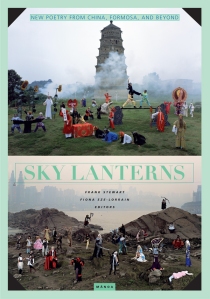 Presented by Manoa: A Pacific Journal of International Writing
Presented by Manoa: A Pacific Journal of International Writing
Editor’s Note, vii
ESSAY
Ancient Enmity
Bei Dao, 1
from Life on Earth
Wei An, 56
Continue reading “Manoa, vol. 24, no. 1 (2012): Sky Lanterns: New Poetry from China, Formosa, and Beyond”
The Contemporary Pacific, vol. 24, no. 2 (2012)
About the Artist: Ani O’Neill, vii
ARTICLES
Pills, Potions, Products: Kava’s Transformations in New and Nontraditional Contexts
Jonathan D Baker, 233
Abstract: This article focuses on kava (Piper methysticum G. Forst, Piperaceae) in its various forms: plant, beverage, medicine, and dietary supplement. Continue reading “The Contemporary Pacific, vol. 24, no. 2 (2012)”
Damien by Aldyth Morris Revisited
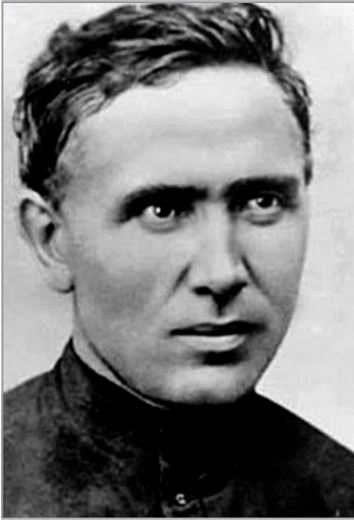 This weekend, July 28 and 29, University of Hawai‘i at Mānoa Outreach College presents two performances of DAMIEN, the award-winning one-man play by Aldyth Morris. The riveting drama of Saint Damien’s life in Hawai‘i will be performed by actor Dann Seki and directed by Tim Slaughter. The entire playscript is included in Almost Heaven: On the Human and Divine (Mānoa 23:2), which will be available for sale at the performances. The 1980 edition of the play is still available by order from UH Press.
This weekend, July 28 and 29, University of Hawai‘i at Mānoa Outreach College presents two performances of DAMIEN, the award-winning one-man play by Aldyth Morris. The riveting drama of Saint Damien’s life in Hawai‘i will be performed by actor Dann Seki and directed by Tim Slaughter. The entire playscript is included in Almost Heaven: On the Human and Divine (Mānoa 23:2), which will be available for sale at the performances. The 1980 edition of the play is still available by order from UH Press.
Act One opens with a chant, written originally in Hawaiian by a composer and hula master who contracted leprosy and died at the Kalaupapa settlement on Moloka‘i. “Song of the Chanter Ka-‘ehu” begins:
What will become of Hawai‘i?
What will leprosy do to our land—
disease of the despised, dreaded alike
by white or brown or darker-skinned?Strange when a man’s neighors
become less than acquaintances.
Seeing me they drew away.
They moved to sit elsewhere, whispering,
and a friend pointed a finger:
“He is a leper.”
Journal of Korean Religions, vol. 3, no. 1 (2012): Late Chosŏn Buddhism
Editor’s Introduction
Boudewijn Walraven, 5
The past century has seen a huge imbalance in the study of Korean Buddhism. Most attention has been devoted to the early period and particularly to Buddhism in Silla, where Wŏnhyo (617–686) emerged as a towering figure whose influence reached far beyond the Korean peninsula. Koryŏ, too, received considerable attention, particularly thanks to the printing of the Tripitaka, which became the basis for the Taishō Canon that is used as a standard edition by modern buddhologists. … With the advent of the Chosŏn court in 1392, however, the gradual adoption of Neo-Confucianism as the new state’s ideology implied a drastic deterioration of the position of Buddhism, which no longer could claim to be the dominant system of belief and was severely weakened institutionally. Twentieth-century scholars of Korean Buddhism (among whom quite a few Japanese) accordingly adopted a negative perspective on Chosŏn Buddhism. … Yet, Late Chosŏn Buddhism merits more attention, at the least because of the important role it continued to play in society, perhaps not at the official, public level, but in the private lives of people of all classes.
Continue reading “Journal of Korean Religions, vol. 3, no. 1 (2012): Late Chosŏn Buddhism”





